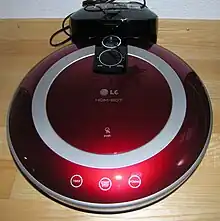LG Roboking
Roboking (Also known as Hom-Bot) is an automated robotic vacuum cleaner produced by LG. The first version of the Roboking was launched during 2001. It is also sold as Hom-Bot. As of 2011, it is the quietest vacuum cleaner robot on the market, producing 48 decibels (dB).


Operation
The Roboking navigates by performing SLAM (simultaneous localization and mapping) to build a map of its environment using ceiling images, while tracking its incremental movement with a downward-facing camera (like an optical mouse). A combination of ultrasound and infrared helps minimize collisions in dynamic environments and optimizes performance by planning the most efficient route. LG claims that these sensors are more effective than the more conventional options of bumpers or light sensors. During homing, the robot goes directly to the remembered location of the charging station rather than looking for it with the help of sensors. Remembered path also helps it to clean multiple rooms.
Like most of other cleaning robots, Roboking is capable of independent docking with its charging station and of scheduled cleaning that starts after the specified number of hours. It cannot be programmed to clean periodically without user interaction and must be serviced after cleanup to empty the dust bin. Remote control provides commands for cleanup, homing, steering and timer setup.
It is reported that the lack of bumper sensors causes the Roboking to push up against obstacles without realizing it, possibly moving them. "This pushing against objects is the single biggest issue with this product.[1]". However 2011 year model has ultrasonic sensors to slow down and turns back if it cannot pass the obstacle.[2] The device is also both advertised and described in reviews[3] as comparatively silent.
Technical details
The 2011 year model contains 22 sensors attached on 32 bit microprocessor.[3] The device runs Linux kernel 2.6 and internally uses Bash, BusyBox, U-boot, glibc and OpenSSL.[2] Source code, where required by the licenses, is available from the address, included in the manual. 1900 mAh Lithium-ion polymer battery is sufficient for 75 minutes of cleaning. The cleaning mechanism is relatively well enclosed and the dust bin is fully closed when removed, resulting cleaner and less maintenance.[1]
The 5906 models use a simpler design, based around a MicroChip dsPIC33FJ256 microcontroller (See photos), although the details of the code are unknown. There is no camera in this model, and it contains the following sensors:
- 5 Ultrasonic sensors to detect walls (designed by Y.M. Kim according to the PCB)
- 3 Optical cliff sensor modules (type unknown).
- 4 Infrared receivers used for both the remote and to locate the docking station.
- A downward-facing optical sensor with 4 visible red LEDs for odometry.
- A MicroInfinity R1350N IMU device for positioning
- A piezoelectric microphone for "dirt detection"
The drive motors also feature a hall-effect sensor, but this is not used in this module, because the pins on the PCB are unused, even though the wiring harness brings the signals from the motor to the main PCB.
Cleaning modes

The device offers several cleaning modes. During the spot cleaning the robot circles around small, highly contaminated area. During Zig Zag cleaning, it attempts to cover all space in long "wall to wall" sections, resulting in faster but possibly less accurate cleaning. During Cell by Cell (or spatial extension) cleaning it divides the bigger area into cells and cleans each cell separately, only moving to the next cell after the current one is complete. It can also be directly steered with remote control.
Real time image streaming
The 2011 year model VR6180VMNC has the third camera and can stream live images through Wi-Fi.[4] Wi-Fi can also be used to control the cleaner from PC or smartphone. This robot also understands voice commands.
Models
As of 2011, 14 models have been released. These models are grouped in three generations. Further models have since been released.
Generation 1
LG VR4000
LG VR4200
LG VR5906KL
LG VR5906LM
V-Model
LG VR5901KL
LG VR5902KL
LG VR5903KL
LG VR5903KLW
LG VR5904KL
P-Model
LG VR5906KL
LG VR5907KL
LG VR5908KL
LG VR1027R
Generation 3
LG VR6170LVM
LG VR6171LVM
Generation 4 [2017-]
LG VR1227R
LG VR1128SIL
LG VR1126TS
LG VR6260LV
LG VR6260LVM
LG VR6270LVM
LG VR6270LVMB
LG VR6470LVM
LG VR6570LVM
See also
References
- Berglund, Per. "LG Roboking Review". Per Berglund. Archived from the original on 11 October 2011. Retrieved 2 September 2011.
- User manual of VR5902LVM
- Roboking Review Archived 2006-05-14 at the Wayback Machine
- "LG Roboking Triple Eye vacuum bot gets Wi-Fi, remote camera". Archived from the original on 2011-12-27. Retrieved 2011-09-28.